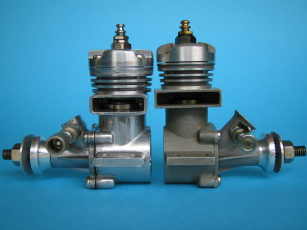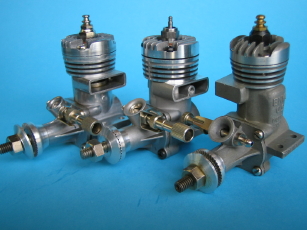| The excellent little ENYA
09 is fast approaching its 50th birthday and in all that time, it
has only progressed through 4 evolutionary marks or models, which
speaks volumes for the soundness of the basic design, conceived
as it was in the early fifties.

Unlike its even smaller siblings, the 09 was intended
for the export market right from the start, and again unlike the
049, 08 etc., the 09 was very much a scaled down 'big' engine, scorning
screw in cylinders and opting instead for the superior all bolted
construction. As an aside, as the smaller models from 08 downwards
were intended only for the Japanese home market, they did not have
proper trade approval and as such, invariably came with instructions
printed in Japanese. These smaller Enya's too, could not match the
09's quality of construction, and as an example I well remember
the first time, back in the 1960's, that I removed the backplate
from my 06 glow to be confronted by a con-rod which had been stamped
from brass or bronze sheet medal. Piston/ cylinder fit was another
area where the 09 outclassed the 'tiddlers' and all the examples
I've examined have fits and finishes every bit as good as the 29's
and 35's in my collection, and that means world class. The 09 too,
had a conventional con-rod and gudgeon pin, not a piston thimble
or carrier held in place by a wire circlip.

The very first 09 appeared in May 1954, designated
as a Model 3001 and was characterised by an exhaust stack that looked
too big, and a rather spindly looking crankshaft. Other visual features
to relate it to it's bigger brothers, were the rounded head fins,
slotted screws and the words ' Made in Japan' cast in the edge of
the L.H. mounting lug. Internally, it also followed the ' big uns'
by having a counter balanced shaft running in a proper bronze bush
and rectangular transfer port cut into the liner with corresponding
bulge on the exterior of the case. This early 09 (like the 19 from
the same era) could be fitted with a factory made radial mount,
cast in similar alloy to the crankcase and is pictured on early
instruction sheets wearing this neat 2 screw mount. Factory stats.
quoted were -weight 2.7 oz., compression ratio 7:1, max. power 0.17
hp @ 16,000 rpm and a 'square' bore & stroke of 0.50 x 0.50
in. giving a capacity of 0.098 cu. in . or 1.61 cc.
Enya released their 09 at a time when small glows
of that size were rare and the 2 most prominent engine tester's
of the day (Ron Warring & Peter Chinn) warmed to the little
motor designed by Saburo Enya, who even then was held in high respect.
Regarded as a 'delightful' engine, both for it's easy handling and
above average power, it also impressed with it's quality, often
lacking in small model diesels especially, which was pretty much
the only alternative available back then.
Speaking from experience, I can tell you that as a
rank beginner trying to start a cantankerous diesel with nobody
to help, those easy starting small glows came as an absolute God
send and represented to me at least, a quantum leap forward in technology.
Due to a relatively short production span of only
around 5 years, that first 09 was not produced in vast numbers,
most being the standard venturi, C/L type although in the late fifties
it did appear with a simple, rotating barrel R/C throttle valve
for the then fledgling radio market. During this time too, the Enya
company was struggling to meet world demand for all it's engines.
An expansion programme had started as early as 1953 with a new &
bigger factory being built in Nerima, and again at Kawagoe in 1964.
The first new engine to come out of the facility at Kawagoe was
the greatly improved Enya 60- II ( sporting a shiny alloy case )
in 1965.
In 1960 a new improved 09 appeared, designated simply
as the 09 -II and with this model, the designer sought to maintain
performance and quality standards, but at the same time lower the
cost of production. This was achieved very cleverly by a change
in the manner in which the fuel/air mixture was transferred from
the lower crankcase to the upper cylinder for combustion.
Instead of the previous thin cylinder liner with 2
diametrically opposed slots for transfer & exhaust ports, the
Enya 09-II featured a very thick (around 2.5 mm) liner with 2 vertical
grooves or 'flutes' machined into the inner surface, which served
as transfer passages. This resulted in a very sturdy and rigid cylinder
liner, which in a small 2 stroke translates to more consistent and
reliable performance. Not only that, but the engine looked sleeker
now, due to the fact that the transfer bulge was not needed on the
side of the crankcase casting. Other changes included the exhaust
now being on the opposite (L.H.) side, and the entire motor was
now shiny alloy instead of the previous models matt grey castings.
While the bore & stroke of the 09-II remained the same as those
for the Mk. 1 engine and a similar crankshaft was used , the new
engine used all new castings and with a lower cylinder height ,
looked more modern. Like all the other models in the range, the
09 was now bolted together using quality chrome plated Phillips
head screws, the factory having made the switch from slotted screws
in the late 50's.
Weight had crept up a bit to over 3oz. but power also
jumped to a maximum of 0.176 b.h.p. at around 16,000 rpm (this though
with a fairly heavily nitrated fuel). On mild fuel, the power was
still around 0.115 b.h.p. at nearly 13,000 rpm and the general impression
was of an extremely well made, rugged engine which ran smoothly
at speeds approaching 20,000 rpm. All this, and the Enya 09 remained
an easy starter and eminently suitable for a rank beginner irrespective
of prop. size. Peter Chinn was amazed that the 09 was equally happy
at 19,500 rpm on a 6x4 'toothpick' or displaying diesel like torque
to turn a 9x6 @ 8,000 rpm. and in his annual review of engines tested
(Model Aircraft Jan. 61) Peter summed it up thus - 'The Enya 09
Series 2 emerged as the most powerful 09 class engine yet handled'.
As good as the 09 -II was, an even more impressive
version appeared in 1966 in the shape of the new Enya 09 - III,
which raised the bar even higher and is probably the definitive
09, the early ones especially being beautifully made.
Even though the III looked very similar to the II
(retaining that nifty little non - flex needle valve) it was basically
a complete redesign with all new parts including a bigger, retimed
crankshaft with larger gas passages. The major difference though,
was the bore was now bigger with a shorter stroke (13 mm x 12.2
mm) which lowered the overall height, and making it an 'oversquare'
engine for the first time. Despite the new cylinder having quite
conservative timing, the new 09 proved to be second only to the
power yardstick of the day, the Cox Tee - Dee 09, and then only
because of the Cox's higher peaking speed. Peter Chinn found, in
fact, that up to 14,000 rpm the Enya was actually the better of
the two, and it's greater torque allowed it to turn big props. like
a 10 x 3.5 at over 8000 rpm with 'nonchalant ease' (Peter's words).
All this happened nearly 40 years ago - the Enya 09
went on to it's final incarnation in the model IV (including a very
nice , single ball race version with red anodised prop. driver -
BB stamped on front housing) which is still produced, the later
ones with ridiculously oversized exhaust and needle valve and now
with a cheap steel washer in the place of the lovely Enya trademark
turned alloy prop. washer.
Footnote - Piston Binding!
No mass produced mechanical device can be guaranteed to be 100% perfect however, and Enya's are no different.There is always (no matter how rare) that occasional “dud”, even in cars like the bullet proof Toyota Camry !
It was while reassembling an Enya 09-III (which I had just cleaned) that I first encountered a quirky problem, possibly unique to Enya (only in the smaller 09 and 15 sizes it seems ) that a couple of other owners had apparently found too. This problem manifested itself as a binding or “grabbing” piston, anytime the head bolts were anything more than finger tight. Most engines with a “drop-in” cylinder liner have a flange at the top of the liner which is clamped between the head and the top of the main case casting. The Enya’s liner however has no flange whatsoever, the straight sided tube being held in position at its lower extremity upon a very narrow machined “ledge” (or projecting annular surface) inside the case, and compressed downwards by the retaining head. This “ledge” is not the same width all around either, being wider on the exhaust side and narrower on the bypass side, so that the transfer flutes are in no way restricted. The liner is very thick (and distortion free) for most of its circumference, but is quite thin where the transfer ports are cut, so whether the problem is caused by a slight machining error in either the base of the liner or the off-centre “ledge”, or perhaps the hole into which the liner fits is not precisely perpendicular to the head when the bolts are tightened ? Also possible is a slight distortion where both the “ledge” and liner are thinnest, or maybe a combination of all these factors. Either way, something is not quite “square”, even though everything works smoothly when the engine is assembled minus the 4 head bolts. I must have pulled that 09 apart 20 times trying to stop that piston from binding, using different tightening sequences, but all to no avail. This exercise had one positive outcome though - I discovered just how tough the alloy is in Enya crankcases. After pulling down and reassembling all those times, the head screws were still snug and tight in their threads. I am only aware of maybe 3 or 4 cases of this strange problem so don't be put off buying one of the best little engines ever made ! |